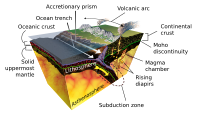
Photo from wikipedia
Abstract The remnants of an island arc system of Pinwarian age, the Escoumins supracrustal belt (ESB), are exposed for over 100 km in the Low-pressure belt of the Central Grenville Province… Click to show full abstract
Abstract The remnants of an island arc system of Pinwarian age, the Escoumins supracrustal belt (ESB), are exposed for over 100 km in the Low-pressure belt of the Central Grenville Province (Canada), and are part of the Quebecia terrane. The ESB mainly consists of amphibolite-facies supracrustal rocks with well preserved primary textures (Saint-Simeon Group; SSG), and their plutonic counterpart (Tadoussac Intrusive Suite; TIS) that provide a record of the evolution of a Mesoproterozoic arc system. Granodiorite (1502 ± 6 Ma) and tonalite of the TIS have calc-alkalic oceanic arc signatures, positive eNd (+2.66) with old model age (1672 Ma) consistent with remelting of previously formed juvenile mafic crust and interaction with an older crustal component, and are crosscut by younger within-plate granitoids. Tectonically above the TIS, the lowest formation of the SSG (Saint-Paul-du-Nord) consists of sedimentary, and minor basalt, intruded by syn-volcanic juvenile (eNd = +5.21) tholeiitic gabbro and is interpreted to represent the remnants of an oceanic basin adjacent to an arc. The middle formation (Moulin-a-Baude) records an evolution from: (a) subalkaline tholeiitic to transitional arc basaltic andesite, basalt, and minor calc-alkalic volcanic arc 1492 ± 3 Ma dacite with crustal-derived signature (eNd = −0.77, model age of 1936 Ma), to (b) transitional to tholeiitic dacite–rhyodacite and 1464 + 38/−32 Ma rhyolite, and (c) subalkaline juvenile (eNd = +3.91–+4.92) tholeiitic basalts and FeTi basalts of arc rift and back-arc affinities. This formation is interpreted to represent an oceanic arc undergoing rifting. Finally, the upper formation (Port-aux-Quilles) is composed of epiclastic sedimentary rocks with detrital zircon of Laurentian affinities, indicating proximity of the arc to Laurentia, but dominated by 1.5–1.47 Ga ages, showing a maximum age of deposition of 1476 ± 10 Ma. The eNd and Nd-model ages indicate an association of mixed crustal and mantle-derived signatures typical of Quebecia crust combined with younger depleted mantle-derived basaltic magma. The data provide new insights on the organisation of Quebecia, and show that crust formed in an oceanic arc setting during late Geon 15 to Geon 14 constitutes a significant component of the central Grenville Province.
Journal Title: Precambrian Research
Year Published: 2018
Link to full text (if available)
Share on Social Media: Sign Up to like & get
recommendations!